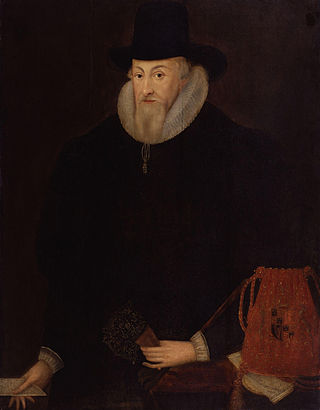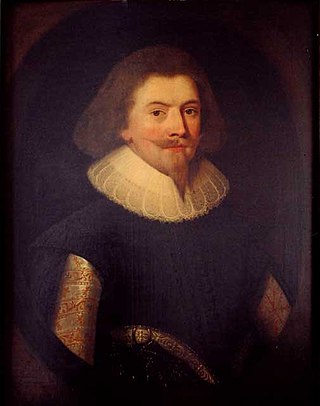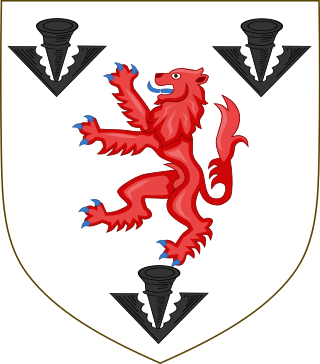Related Research Articles
Duke of Buckingham, referring to Buckingham, is an extinct title that has been created several times in the peerages of England, Great Britain, and the United Kingdom. There were creations of double dukedoms of Buckingham and Normanby and of Buckingham and Chandos. The last holder of the dukedom died in 1889.

Duke of Sutherland is a title in the Peerage of the United Kingdom which was created by William IV in 1833 for George Leveson-Gower, 2nd Marquess of Stafford. A series of marriages to heiresses by members of the Leveson-Gower family made the dukes of Sutherland one of the richest landowning families in the United Kingdom. The title remained in the Leveson-Gower family until the death of the 5th Duke of Sutherland in 1963, when it passed to the 5th Earl of Ellesmere from the Egerton family.
The Peerage of the United Kingdom is one of the five Peerages in the United Kingdom. It comprises most peerages created in the United Kingdom of Great Britain and Ireland after the Acts of Union in 1801, when it replaced the Peerage of Great Britain. New peers continued to be created in the Peerage of Ireland until 1898

Earl of Halifax is a title that has been created four times in British history—once in the Peerage of England, twice in the Peerage of Great Britain, and once in the Peerage of the United Kingdom. The name of the peerage refers to Halifax, West Yorkshire.

Earl Granville is a title that has been created twice, once in the Peerage of Great Britain and once in the Peerage of the United Kingdom. It is now held by members of the Leveson-Gower family.

Baron Brownlow, of Belton in the County of Lincoln, is a title in the Peerage of Great Britain. It was created in 1776 for Sir Brownlow Cust, 4th Baronet. The Cust family descends from Richard Cust (1622-1700) of The Black Friars, Stamford, who represented Lincolnshire and Stamford in Parliament. In 1677 he was created a baronet, "of Stamford in the County of Lincoln". He was succeeded by his grandson Richard Cust, 2nd Baronet, who married Anne Brownlow, daughter of Sir William Brownlow, 4th Baronet, "of Humby", Lincolnshire, and sister and sole heiress of John Brownlow, 1st Viscount Tyrconnel, 5th Baronet of Belton House, Lincolnshire. The 2nd Baronet's son Sir John Cust, 3rd Baronet, sat as a Member of Parliament for Grantham and served as Speaker of the House of Commons from 1761 to 1770 and in 1754 inherited the Brownlow estates, including Belton, on the death of his childless maternal uncle Viscount Tyrconnel. His son Brownlow Cust, 4th Baronet, represented Ilchester, Somerset, and Grantham in Parliament and in 1776 was raised to the peerage as Baron Brownlow, "of Belton in the County of Lincoln", chiefly in recognition of his father's services. He was succeeded by his son John Cust, 2nd Baron Brownlow, who had sat as a Member of Parliament for Clitheroe, Lancashire, and also served as Lord Lieutenant of Lincolnshire for many years. In 1815 he was created Viscount Alford, "in the County of Lincoln", and Earl Brownlow, both in the Peerage of the United Kingdom. In 1810 the future 1st Earl had married Sophia Hume, a daughter of Sir Abraham Hume, 2nd Baronet, of Wormleybury, by his wife Lady Amelia Egerton, a great-granddaughter of John Egerton, 3rd Earl of Bridgewater.

Baron Hunsdon is a title that has been created three times.

Earl of Ellesmere, of Ellesmere in the County of Shropshire, is a title in the Peerage of the United Kingdom. It was created in 1846 for the Conservative politician Lord Francis Egerton. He was granted the subsidiary title of Viscount Brackley, of Brackley in the County of Northampton, at the same time, also in the Peerage of the United Kingdom. Born Lord Francis Leveson-Gower, he was the third son of George Leveson-Gower, 1st Duke of Sutherland and Elizabeth Gordon, 19th Countess of Sutherland. In 1803 his father had inherited the substantial estates of his maternal uncle Francis Egerton, 3rd Duke of Bridgewater. On his father's death in 1833, Lord Francis succeeded to the Egerton estates according to the will of the late Duke of Bridgewater, and assumed by Royal licence the surname of Egerton in lieu of Leveson-Gower. The Brackley and Ellesmere titles created for him in 1846 were revivals of titles held by the Dukes of Bridgewater. In 1963 his great-great-grandson, the fifth Earl, succeeded his kinsman as 6th Duke of Sutherland. The earldom of Ellesmere and viscountcy of Brackley are now subsidiary titles of the dukedom.

Earl of Bridgewater was a title that has been created twice in the Peerage of England, once for the Daubeny family (1538) and once for the Egerton family (1617). From 1720 to 1803, the Earls of Bridgewater also held the title of Duke of Bridgewater. The 3rd Duke of Bridgewater is famously known as the "Canal Duke", for his creation of a series of canals in North West England.
Baron Egerton, of Tatton in the County Palatine of Chester, was a title in the Peerage of the United Kingdom. It was created on 15 April 1859 for William Egerton (1806–1883), a politician from the Egerton family.

Francis Egerton, 3rd Duke of Bridgewater, known as Lord Francis Egerton until 1748, was a British nobleman from the Egerton family. He was the youngest son of the 1st Duke. He did not marry, and the dukedom expired with him, although the earldom was inherited by a cousin, Lieutenant-General John Egerton.

John Egerton, 2nd Earl of Bridgewater, PC, was an English nobleman from the Egerton family.

Thomas Egerton, 1st Viscount Brackley,, known as Lord Ellesmere from 1603 to 1616, was an English nobleman, judge and statesman from the Egerton family who served as Lord Keeper and Lord Chancellor for twenty-one years.

John Egerton, 3rd Earl of Bridgewater KB PC was a British nobleman from the Egerton family.

Scroop Egerton, 1st Duke of Bridgewater, styled as Viscount Brackley from 1687 to 1701 and as the Earl of Bridgewater from 1701 to 1720, was an English peer, courtier and landowner. Born into the Egerton family, he succeeded as Earl of Bridgewater in 1701, before being created Duke of Bridgewater on 18 June 1720, with subsidiary titles including Marquess of Brackley.
The Egerton, laterGrey Egerton, later stillEgerton baronetcy, of Egerton and Oulton in the county of Chester, is a title in the Baronetage of England held by the senior patrilineal branch of the Egerton family.

John Egerton, 1st Earl of Bridgewater, KB, PC, was an English peer and politician from the Egerton family.

The Egerton family is a British aristocratic family. Over time, several members of the Egerton family were made Dukes, Earls, knights, baronets and peers. Hereditary titles held by the Egerton family include the dukedoms of Bridgewater (1720–1803) and Sutherland, as well as the earldoms of Bridgewater (1617–1829), Wilton (1801–1999) and Egerton (1897–1909). Several other members of the family have also risen to prominence. The Egerton family motto is Virtuti non armis fido.
Jane Egerton, Countess of Bridgewater, was the second wife of John Egerton, 3rd Earl of Bridgewater. She was a daughter of Charles Paulet, 1st Duke of Bolton, by his second wife Mary Scrope.

Sir Thomas Egerton was an English landowner, soldier and politician who represented Cheshire in the House of Commons from 1597 to 1598.
References
- ↑ Hopkins, E. (1962). "The Re-Leasing of the Ellesmere Estates 1637–1642". The Agricultural History Review. 10 (1): 14–28 – via JSTOR.
- ↑ "Egerton family papers, Huntington Library: Finding Aid". oac.cdlib.org– via Online Archive of California.